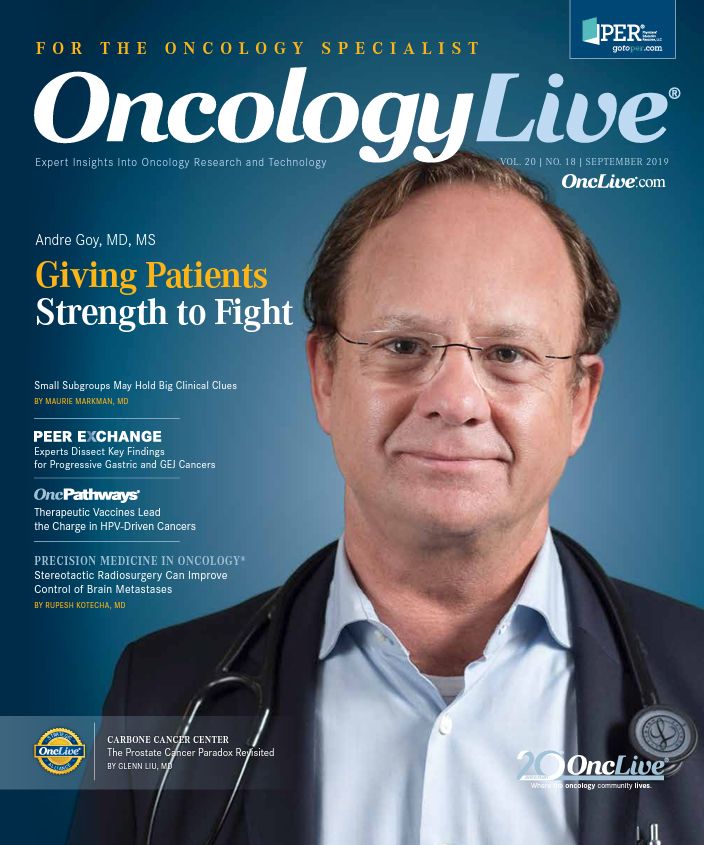Small Subgroups May Hold Big Clinical Clues in Oncology
With the revolution in our understanding of cancer’s basic molecular biology, it is increasingly evident that subgroups of cancer originating from specific regions of the body have unique natural histories and respond to very different therapeutics. For example, the importance of BRCA mutations, which define a subset of ovarian cancers impressively sensitive to PARP inhibitors, has striking altered the management of this group of gynecologic malignancies.

Maurie Markman, MD
Phase III randomized trials have played a critical role in the development of modern cancer therapeutics. It would be difficult to imagine what cancer care would look like today in the absence of well-designed, appropriately conducted, ultimately reported, and solidly evidence-based clinical studies.
This has certainly been the case for antineoplastic therapy in the management of the gynecologic malignancies. From what is now the standard-of-care administration of a platinum drug plus a taxane in the treatment of advanced ovarian cancer to the delivery of cisplatin-based chemoradiation in locally advanced cervix cancer, optimal care has been defined through these critical clinical investigative efforts.
However, with the revolution in our understanding of cancer’s basic molecular biology, it is increasingly evident that subgroups of cancer originating from specific regions of the body (eg, breast, colon, lung, ovary) have unique natural histories and respond to very different therapeutics. For example, the importance of BRCA mutations, which define a subset of ovarian cancers impressively sensitive to PARP inhibitors, has striking altered the management of this group of gynecologic malignancies.1
When it comes to randomized trials, the traditional use of information regarding specific subgroups has been to ensure relative equalization of patients with known relevant prognostic factors (eg, age, sex, stage, tumor grade) into the 2 or more arms of a study, with the goal of creating groups as homogeneous as possible except for the therapy under investigation.
This commentary addresses the question of what happens when 1 of these hypothesized prognostic factors or subgroups is discovered to be of actual predictive relevance, meaning the therapy under study may be either more effective or less (or more toxic or less) than recorded in the combined total patient population.
“Very interesting,” you might say when viewing the results of a completed phase III trial, but the limited size of the patient subgroup will likely make it difficult, if not impossible, to draw any definitive conclusions based on accepted statistical principles. The response to such an observation might be “This is hypothesis generating,” so the next step is to conduct another phase III trial that focuses on this subgroup.
If one is considering 20% to 25% of patients with a common cancer type, such as activating EGFR mutations in non—small cell lung cancer, conducting a phase III trial is reasonable. However, what if one is considering a subgroup involving 5% to 10% of patients with a relatively uncommon malignant condition?
Gynecologic Results Illustrate Nuances
Consider the management of endometrial cancer—specifically, the subgroup of women with serous histology. In a recently reported phase III randomized trial (GOG- 0249), patients with high-intermediate and high-risk early-stage disease were randomized to receive adjuvant pelvic radiation therapy or vaginal brachytherapy plus carboplatin/paclitaxel.2 In this 601-patient study, 74% had stage I disease; 14.6% (n = 88) of the randomized patient population had serous histology.
The findings revealed no difference in 60-month relapse-free or overall survival in the entire patient population. Further, the investigators noted that acute toxicity was greater with the combination strategy. Their conclusion: “Pelvic radiation therapy alone remains an effective, well-tolerated, and appropriate adjuvant treatment in high-risk early-stage endometrial carcinomas of all histologies.”2
However, rather buried in the text (in figure 4) was a forest plot of recurrence-free survival data for various patient subsets. Among the very small group (n = 21; 3.5% of the entire population) with stage II serous or clear cell histology, the hazard ratio for improved outcome associated with the delivery of vaginal radiation plus chemotherapy compared with pelvic radiation alone was 0.39, with a large confidence interval (0.12-1.28).2
Although it would be completely inappropriate to conclude that the combination approach was superior, it is reasonable to seriously question the conclusion regarding the absence of potential relevance of chemotherapy in high-risk serous endometrial cancers.
Additionally, consider the recent findings of a randomized phase II study of carboplatin/paclitaxel compared with this chemotherapy combined with trastuzumab (Herceptin) in uterine serous endometrial cancer that were shown to overexpress HER2.3 Estimates for HER2 overexpression in this malignancy range widely, from 14% to 80%, indicating a critical unknown in this uncommon histology. However, among the trial’s 61 patients, the use of trastuzumab significantly improved progression-free survival (median 12.6 months vs 8.0 months; P = .005; HR, 0.44).3
Framework for Decisions is Possible
How does one incorporate such data into routine clinical paradigms? To be clear, it is unlikely that an appropriately powered randomized phase III clinical trial directly addressing this critical question will ever be conducted.
In a case-based commentary that appeared in the same journal issue as the GOG-0249 trial, the authors emphasized the overall absence of definitive evidence-based data supporting the delivery of chemotherapy in early-stage intermediate- and high-risk endometrial cancer, yet they concluded that “in the setting of higher relapse rates and worse survival, and given the uncertainties in data interpretation as a result of small subsets, we do recommend that adjuvant chemotherapy be considered for patients with earlystage serous and clear-cell carcinoma.”4
This is an appropriate conclusion and challenges the broad statement regarding the lack of utility based on the results of a phase III trial that included just a small patient subgroup of women with serous histology. Further, this study outcome raises a meaningful challenge to the rigid compliance with statistical rules regarding study interpretation or the demands to achieve a mandated patient sample size in a time period permitting completion of a trial. Finally, a rigorous review of trial design, certain study assumptions, and an understanding of both relevant biology and clinical science must at times trump the mandates of formal statistical analysis.
References
- Markman M. Poly(ADP-ribose) polymerase inhibitors in the management of ovarian cancer. Womens Health (Lond). 2018;14:1745505717750694. doi: 10.1177/1745505717750694.
- Randall ME, Filiaci V, McMeekin DS, et al. Phase III trial: adjuvant pelvic radiation therapy versus vaginal brachytherapy plus paclitaxel/carboplatin in high-intermediate and high-risk early stage endometrial cancer. J Clin Oncol. 2019;37(21):1810-1818. doi: 10.1200/JCO.18.01575.
- Fader AN, Roque DM, Siegel E, et al. Randomized phase II trial of carboplatin-paclitaxel versus carboplatin- paclitaxel-trastuzumab in uterine serous carcinomas that overexpress human epidermal growth factor receptor 2/neu. J Clin Oncol. 2018;36(20):2044-2051. doi: 10.1200/JCO.2017.76.5966.
- Jang JW, Lee LJ. External beam, brachytherapy, or chemotherapy? defining adjuvant therapy for early-stage and high- and high-intermediate-risk endometrial cancer. J Clin Oncol. 2019;37(21):1778- 1784. doi: 10.1200/JCO.19.00362.




